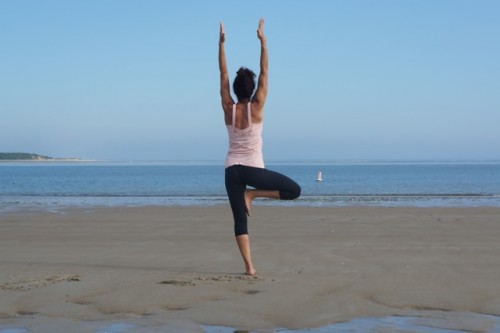
One of the themes I love to focus on when teaching are the muscles on the sides of the body. I was doing some reading yesterday about myofacial lines. I’m just starting to learn about this concept and I love it because it involves the biomechanics of the body and fascia as well as muscle. When you think of fascia being the connective tissue that surrounds the muscles and you think of the biomechanics of the body being the ability to move the body in a coordinated way, the idea of working with the myofascial lines of the body is a natural next step.
I love the idea of working with the lateral lines of the body. This is where I got the idea for the concept of “pillars of strength.” The sides of the body can be thought of as the columns that support the outside edges and one can think of the spine as being the central pillar. When you think of all the things that the outer pillars are responsible for, you can imagine actions like standing, running, picking things up and also the idea that the strength of the outer edges supports the middle part of the body.
The muscles that are on the lateral lines of the body include things like the deltoids, the latissimus dorsi, the serratus anterior, the obliques, the gluteus medius and the lateral muscle of the quadriceps, the vastus lateralis. As you reach the shin, you come across the muscle the peroneus longus. Even without knowing the exact muscles of the sides of the body, you can see that if you envision them all working to some degree together, you can understand how a problem with one can create problems in the other. Then, when you imagine they’re all wrapped in connective tissue, called fascia, you have a huge working unit on either side of the body.
Pillars in the body are there for strength and pillars in our life are there to create stability so we can withstand the storms that can rock our world from time to time. Pillars in our life can also represent our values, our integrity, what we stand for and how we hold our body and ourselves in different situations. As we help our students connect to these physical lines in the body, we hopefully help them connect to their underlying strength on all levels.
Poses that can target this area will include anything that involves side bending or balancing on one leg. You can test someone’s side body strength and it’s “evenness” from side to side by asking them to stand on one leg while watching for shifts in the level of their pelvis. The idea is that when someone is on one leg, the other lateral line of the body will compensate to keep them from dipping into the other hip. When you think of someone running, that side body strength is critical to prevent rocking of the pelvis from side to side while on the road.
You can work poses that strengthen the sides of the body as well as stretch it. Strengthen poses might include Side Plank or Side Angle and challenge poses might include Boat Pose with a variation of twisting. You can also really challenge students by doing Side Crow, Half Moon and Reverse Half Moon. I love using a variation on Triangle that I’ve seen before when you lean into one side and extend arms out to the side.
What are the pillars of strength in your life? How can you speak from the heart and share these things with your students and inspire them to connect to their strengths? Working with this kind of theme will give you a chance to tap into this concept.
